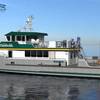The Strategic Council on Security Technology announced the global rollout of Phase Two of the Smart and Secure Tradelanes (SST) initiative. In the last year, SST has become the largest cargo security program in operation, helping global shippers to automatically track the location and status of containers while creating a system to detect and report container tampering. The second phase of SST focuses on further expansion of the global network, extending operations, shipments, and integration into existing supply chain systems while incorporating new technologies such as sensor-equipped smart containers into global supply chain systems.
Smart and Secure Tradelanes (SST) is an industry-funded supply chain security and efficiency initiative. It was founded on the premise that the considerable gaps in global supply chain security put prosperity, free trade, and economic development at risk. In response, the SST industry consortium has pursued solutions that provide economic incentives to finding, innovating, and implementing security solutions.
"We cannot kill the patient with the cure. Security can and must be reinforced by good industry economics that allow governments to get the information they need while allowing industry the ability to gain economic efficiencies through their investments in improved supply chain security," said Stephen Flynn, the Jeanne J. Kirkpatrick Senior Fellow, National Security Studies, Council on Foreign Relations and a leading authority on maritime security.
SST includes over 65 participating companies representing each link in the supply chain and is the largest commercial supply chain security project ever undertaken. The first phase of SST focused on operational and economic results. During Phase One of SST, test cases were developed and data gathered on containers originating in Asia, North America, and Europe and traveling along 18 major tradelanes. Leading authorities on supply chain execution and security analyzed this operational data and a report on SST The report found that Phase 1 demonstrated that improved supply chain security measures also can lead to improved economic efficiency for industry. Phase One results and analysis are available upon request.
"We are proud of what we were able to accomplish in Phase One of SST," said Gen. John Coburn (US Army, Ret.), Chairman of the Strategic Council on Security Technology. "In Phase Two, we will build on the quantifiable successes of the first phase. We will continue to focus on ways to improve both efficiency and security by facilitating trade, better leveraging scarce resources to improve screening and security performance, and further automating existing processes, while developing new capabilities with enabling technologies."
In Phase One, SST participants established that one of its guiding principles would be the adherence to and support of the initiatives and programs established by the United States Bureau of Customs and Border Protection (CBP), the United States Transportation Security Administration (TSA), United States Department of Transportation (DOT), International Maritime Organization (IMO), World Customs Organization (WCO), and other international organizations working to improve the security of the global supply chain. Therefore, Phase Two of SST will continue to focus on how to complement and extend cargo security programs such as the CBP's Customs-Trade Partnership Against Terrorism (C-TPAT) and Container Security Initiative (CSI), TSA's Operation Safe Commerce (OSC), and the United States Trade and Development Agency's STAR/Best program.
In anticipation of CBP's recent announcement that smart containers would become an integral component of anti-terrorism programs, SST Phase One also tested a variety of technologies that in combination provide a model for the wide scale development of smart containers with anti-intrusion and environmental sensors and two-way wireless devices that communicate over radio frequencies with an installed network infrastructure. Earlier this month at the U.S. Maritime Security Expo in New York, three SST participants - E. J. Brooks, RAE Systems, and Savi Technology -- announced an inter-connected modular sensor system that adds new levels of intelligence to cargo containers at very low costs, enabling containers to be configured per shipment to automatically detect intrusions, sense interior environmental changes in temperature or humidity, detect hazardous cargo such as radioactive materials, and wirelessly communicates its location and security status to a global information network in real-time.
Companies or organizations interested in participating in the second phase of SST should contact the SCST by visiting the SCST website at www.scst.info/joinsst.html.
Sponsored Content
Chris-Marine’s solutions help to prolong engine lifetime

Subscribe for
Maritime Reporter E-News
Maritime Reporter E-News is the maritime industry's largest circulation and most authoritative ENews Service, delivered to your Email five times per week












